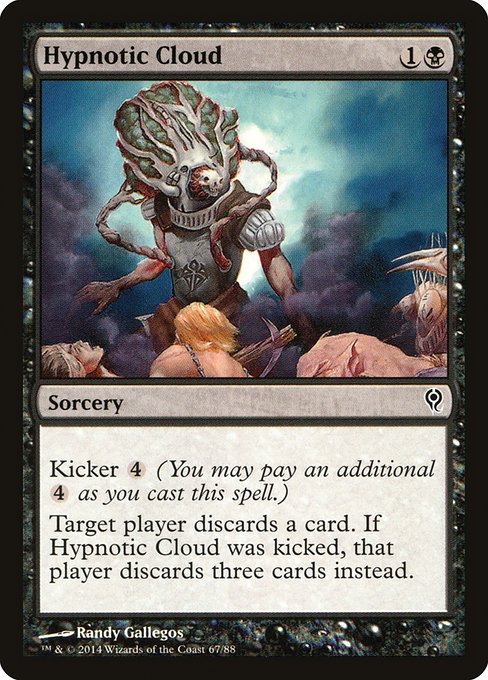
Image courtesy of Scryfall.com
Breaking conventions in black mana: a closer look at a single-sentence disruption
In the world of Magic, designers often chase the delicate balance between efficiency, surprise, and resource management. Hypnotic Cloud arrives with a quiet audacity: for a modest {1}{B} and the option to pay an extra {4}, you unleash a two-part effect that twists a simple “target player discards” into a strategic tug-of-war. The card’s core is a straightforward sorcery—target player discards a card. But if you kick it, that same player must surrender three cards. That payoff, tucked behind a late-game mana spike, is the sort of design that prompts players to think in layers rather than in binary outcomes. 🧙♂️🔥
Released as part of a Duel Deck pairing Jace and Vraska, Hypnotic Cloud embodies an era when designers leaned into modular spells that could feel flexible without tipping into overpowered territory. The mana cost is lean, and the kicker adds a dramatic hinge: a one-for-one disruption becomes a potential three-for-one disruption with the right timing. It’s a reminder that in MTG, a single spell can wear two faces—one economical and one opportunistic—depending on the moment you choose to pay the extra price. 💎⚔️
The artwork by Randy Gallegos anchors that tension visually. A swirl of shadow and suggestion coils into a tangible invisible threat, a thematic fit for a card that asks you to pay more to punch harder. It’s not just about forcing a discard; it’s about destabilizing an opponent’s hand multiple turns later, a notion that resonates with players who savor mind games as much as mana counts. The art communicates the mood even when the card remains (on paper) a straightforward discard spell. 🎨🧪
From a design-history angle, the card pushes against the notion that kicker-heavy effects must be flashy or multi-colored to justify their cost. Here, the kicker exists to escalate a modest effect into a meaningful swing, but it does so in a way that remains accessible to players drafting or casually playing with a Duel Deck on a kitchen table. That marriage of accessibility and depth is part of what makes the card a compelling case study in how design conventions can be bent—rather than broken outright—without losing its identity. 🧙♂️
Two costs, one decision: cost balancing in this cloud spell
The arithmetic is elegant in its simplicity. For two mana, you hit for a single discard. Add four more mana to the mix, and you convert a single card into a trio of hand losses. The judgment call—whether to invest the extra mana—transforms gameplay pacing. Early on, you might cast it for the baseline effect to hamper a key opponent’s curve, but in midgame or late game, the kick payoff rewards you for your patience and your resource advantage. That flexibility is a design luxury that a lot of black-based disruption seeks but doesn’t always achieve with a common-card footprint. 🧩🔥
On the strategic side, this encourages a broader discourse about hand disruption in multiplayer formats. A card that can swing a single draw step into a potential three-card swing invites players to think about tempo, resource denial, and the psychology of timing. The card’s heels are not just in the discard; they’re in the opportunity cost of paying the kicker and the downstream impact on the game’s narrative arc. In casual play, that means the spell can be a surprise finisher; in more competitive environments, it’s a tool to keep pressure on the table while your stack is building. ⚖️🃏
Design, flavor, and cultural reverberations
What does a card like this say about MTG’s evolving design language? It signals a willingness to reward players who pay for extra efficiency while maintaining a lower overall rarity. The common status makes it approachable in deck-building, even as the kicker’s potential creates memorable, game-changing moments. This is precisely the kind of design that lets players feel clever—like their decisions matter not in a single moment but across a sequence of plays. The flavor text (or lack thereof) sits in balance with the visual metaphor: a hypnotic cloud, a mental tether, a reminder that hand disruption is a weapon that often wins games not by brute force but by misdirection and timing. 🧙♂️🎯
From a collector’s lens, the card’s place in a reprint-heavy Duel Decks set adds a layer of nostalgia. It’s not a premier mythic, but its design punch—the contrast between a modest base spell and a powerful kicker—has a kind of memory-value that resonates with long-time players who remember when hand disruption felt like a core component of black’s identity. In the larger MTG culture, that duality—economy vs. payoff, restraint vs. risk—maps cleanly to many classic archetypes. It’s a design conversation about how far a single card can push the envelope without breaking the game’s fragile balance. 💎⚔️
For readers who enjoy pairing MTG with other nerd-forward passions, Hypnotic Cloud provides a natural bridge to discussions about design in other domains. The trick of layering a simple effect with a conditional amplifier is something you’ll see in various game genres and even in interactive product design. It’s a small spell with a big design voice, a reminder that the best mechanics often come in deceptively modest packages. And if you’re constructing a tabletop toolkit, you’ll appreciate how this card rewards careful hand-reading and precise timing—skills that translate to great table presence in any strategic game. 🧙♂️🎲
More from our network
- https://blog.digital-vault.xyz/blog/post/silver-border-showdowns-holy-avenger-in-tournament-play/
- https://crypto-acolytes.xyz/blog/post/color-index-echoes-stellar-age-in-a-hot-giant/
- https://blog.digital-vault.xyz/blog/post/when-to-prioritize-rise-of-the-dark-realms-in-draft/
- https://crypto-acolytes.xyz/blog/post/rio-terminal-hardware-accelerated-gpu-terminal-emulator/
- https://blog.digital-vault.xyz/blog/post/luxurious-paper-simulation-with-lighting-layers/